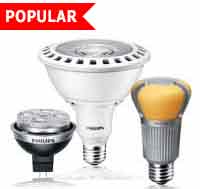The Stage in a Whole New Light: LED Par Cans
In a recent interview in Lighting and Sound America, Broadway theatrical lighting expert, Gary Fails remarked that, “LEDs are the future of lighting, they will change our industry.” Indeed, from the home to the airplane LEDs a re replacing more traditional light sources. This lighting revolution is no more apparent than in Mr. Fails’ own area of expertise, theatrical lighting. Since there have been electrically illuminated stage performances, parabolic aluminized reflectors (Par cans) have provided the light. Typically par cans have used incandescent or halogen bulbs to light up the stage. Like much of the lighting industry, however, this is quickly changing as consumers demand more environmentally friendly and efficient lighting options.
The energy savings of LED par cans are remarkable. Typical par can bulbs are usually incandescent, halogen or high intensity discharge (HID). These bulbs usually require energy draws of between 500w and 1,000w. LED par cans, such as the Optima Par 64 LED, draw only 12w. As with all LED bulbs, LED par cans match their low wattage with high lumen output. In addition to saving you money and energy consumption, LED par cans generate considerably less heat than traditional par can bulbs do, creating a more comfortable stage for performers. The savings LED par cans provide do not end there, however. With LED par cans, you do not need to bother with gel sheets or gel frames as they are integrated into the LED par can.
The range of color that LED par cans can produce is striking. The Optima Par 64 LED, for example, has a total of 183 LEDs bulbs, of which 61 are red, 61 are green, and 61 are blue. By using DMX controllers and downloadable software, one can quickly customize the color of the light, allowing you color flexibility not previously possible with traditional bulbs. Some par cans also come with built in light effects, something not possible with traditional par cans. The Optima Par 64 Pro features built in variable strobes and multiple color programs, giving your lighting an energy and capacity for creativity to match your performances.
Though LED par cans share the benefits of LED technology at large, they also share its temporary downside, namely the higher cost of LED technology. The cost of LED par cans however is temporary and will likely decrease as the technology matures. Furthermore, LEDs par cans save you money not only in energy expenditures, but also in that you no longer have to purchase gel frames or gels. The performance advantages of LED par cans make them a worthwhile investment and serious consideration for any theatre or concert venue owner.











 In order for
In order for  Lately I have been fielding a number of technical questions regarding
Lately I have been fielding a number of technical questions regarding  The search for environmentally friendly lighting for retail, office, architectural floodlighting, and hotel applications has often proved frustrating for individuals seeking low wattage, high output, and high CRI light sources. Striking this combination of light characteristics has been seldom, that is until now.
The search for environmentally friendly lighting for retail, office, architectural floodlighting, and hotel applications has often proved frustrating for individuals seeking low wattage, high output, and high CRI light sources. Striking this combination of light characteristics has been seldom, that is until now.  With the green revolution taking place in lighting, people are looking for long lasting, more efficient lighting options in all applications. One area where a big push for greener lighting has occurred is in horticultural lighting. GE’s line of
With the green revolution taking place in lighting, people are looking for long lasting, more efficient lighting options in all applications. One area where a big push for greener lighting has occurred is in horticultural lighting. GE’s line of  The
The A Purdue University land-use scientist found in 2007 that there are likely more parking spaces in the United States than cars. The scientist found that parking lots in Illinois, Indiana, Michigan, and Wisconsin amounted to about 490 square miles. Parking lots pose numerous environmental problems. One of the most important is how to light these often large lots efficiently for hours on end every day of the year. Fortunately, there seems to be an environmentally friendly solution:
A Purdue University land-use scientist found in 2007 that there are likely more parking spaces in the United States than cars. The scientist found that parking lots in Illinois, Indiana, Michigan, and Wisconsin amounted to about 490 square miles. Parking lots pose numerous environmental problems. One of the most important is how to light these often large lots efficiently for hours on end every day of the year. Fortunately, there seems to be an environmentally friendly solution:





Stay in Touch